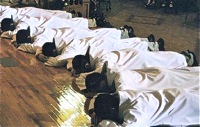Difference between revisions of "Prostration"
m (Text replacement - "http://nordan.daynal.org" to "https://nordan.daynal.org") |
m (Text replacement - "http://" to "https://") |
||
| Line 3: | Line 3: | ||
==Etymology== | ==Etymology== | ||
[https://nordan.daynal.org/wiki/index.php?title=English#ca._1100-1500_.09THE_MIDDLE_ENGLISH_PERIOD Middle English] prostrat, from Anglo-French, from [[Latin]] prostratus, past participle of prosternere, from pro- before + sternere to spread out, throw down | [https://nordan.daynal.org/wiki/index.php?title=English#ca._1100-1500_.09THE_MIDDLE_ENGLISH_PERIOD Middle English] prostrat, from Anglo-French, from [[Latin]] prostratus, past participle of prosternere, from pro- before + sternere to spread out, throw down | ||
| − | *Date: [ | + | *Date: [https://www.wikipedia.org/wiki/14th_Century 14th century] |
==Definitions== | ==Definitions== | ||
*1 : stretched out with [[face]] on the ground in [[adoration]] or submission; also : lying flat | *1 : stretched out with [[face]] on the ground in [[adoration]] or submission; also : lying flat | ||
| Line 11: | Line 11: | ||
'''Prostration''' is the placement of the [[body]] in a [[reverent]]ially or submissively prone position. Major world [[religions]] employ prostration either as an [[act]] of submissiveness to [[God ]] or gods, or as a means of embodying [[reverence]] for a [[noble]] [[person]], persons or [[doctrine]]. Within various [[cultures]] and [[traditions]], prostrations are similarly used to show [[respect]] to [[civil]] [[authorities]] and more accomplished masters. The [[act]] is thus often an important part of [[religious]], [[civil]] and [[traditional]] [[rituals]] and ceremonies. | '''Prostration''' is the placement of the [[body]] in a [[reverent]]ially or submissively prone position. Major world [[religions]] employ prostration either as an [[act]] of submissiveness to [[God ]] or gods, or as a means of embodying [[reverence]] for a [[noble]] [[person]], persons or [[doctrine]]. Within various [[cultures]] and [[traditions]], prostrations are similarly used to show [[respect]] to [[civil]] [[authorities]] and more accomplished masters. The [[act]] is thus often an important part of [[religious]], [[civil]] and [[traditional]] [[rituals]] and ceremonies. | ||
| − | Many [[religious]] [[institutions]] use prostrations to embody the lowering, submitting or relinquishing of the [[individual]] [[ego]] before a greater [[spiritual]] [[power]] or [[presence]].[ | + | Many [[religious]] [[institutions]] use prostrations to embody the lowering, submitting or relinquishing of the [[individual]] [[ego]] before a greater [[spiritual]] [[power]] or [[presence]].[https://en.wikipedia.org/wiki/Prostrate] |
[[Category: Religion]] | [[Category: Religion]] | ||
Latest revision as of 02:37, 13 December 2020
Etymology
Middle English prostrat, from Anglo-French, from Latin prostratus, past participle of prosternere, from pro- before + sternere to spread out, throw down
- Date: 14th century
Definitions
- 1 : stretched out with face on the ground in adoration or submission; also : lying flat
- 2 : completely overcome and lacking vitality, will, or power to rise <was prostrate from the heat>
- 3 : trailing on the ground : procumbent <prostrate shrubs>
Description
Prostration is the placement of the body in a reverentially or submissively prone position. Major world religions employ prostration either as an act of submissiveness to God or gods, or as a means of embodying reverence for a noble person, persons or doctrine. Within various cultures and traditions, prostrations are similarly used to show respect to civil authorities and more accomplished masters. The act is thus often an important part of religious, civil and traditional rituals and ceremonies.
Many religious institutions use prostrations to embody the lowering, submitting or relinquishing of the individual ego before a greater spiritual power or presence.[1]
